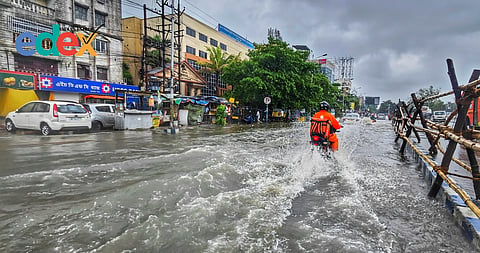

India ranks among the ten countries most affected by extreme weather events over the past three decades, according to the latest Climate Risk Index (CRI) 2026 released by Germanwatch at COP30 in Belém, Brazil. Covering data from 1995 to 2024, the index places India ninth, highlighting its growing vulnerability to heat waves, floods and cyclones that have intensified under global warming.
During this period, India endured nearly 430 extreme weather events, from deadly heat waves and intense monsoons to devastating cyclones, resulting in over 80,000 deaths, 1.3 billion people affected, and economic losses of nearly $170 billion (inflation-adjusted). The report identifies India as a country suffering from “continuous climate threats”, where recurring disasters leave little time for recovery before the next event strikes.
Floods and landslides triggered by heavy monsoons continue to cause widespread destruction. The 2013 Uttarakhand floods, 2019 monsoon floods and recurring deluges in Assam and Kerala exemplify the pattern. Meanwhile, heat waves with temperatures near 50°C, as recorded in Gujarat, Rajasthan and Uttar Pradesh, have become more frequent and prolonged. Cyclones such as Amphan (2020), Fani (2019) and Hudhud (2014) caused extensive human and economic losses, hitting vulnerable coastal communities.
“Countries such as India, Haiti and the Philippines face particular challenges, as they are hit by floods, heat waves or storms so regularly that entire regions can hardly recover before the next event,” said Vera Künzel, senior advisor on climate adaptation and human rights at Germanwatch. “Without more long-term support and adaptation finance, they face insurmountable challenges.”
The CRI 2026 shows that extreme weather has claimed over 832,000 lives globally and caused $4.5 trillion in economic losses over 30 years. Storms accounted for the greatest monetary damage (58 per cent of total losses), floods affected nearly half of all victims, and heat waves and storms caused two-thirds of all fatalities.
India’s inclusion among the top 10 nations underscores how the Global South bears the brunt of climate impacts despite contributing the least to global emissions. Six of the ten most affected countries are lower-middle-income nations. Other countries in the top ten include Dominica, Myanmar, Honduras, Libya, Haiti, Grenada, the Philippines, Nicaragua and the Bahamas. Dominica tops the list, having suffered catastrophic economic losses equivalent to several times its GDP from repeated hurricanes, most notably Hurricane Maria in 2017.
For the year 2024 alone, the Caribbean nations St. Vincent and the Grenadines and Grenada ranked first and second, respectively, following the devastation caused by Hurricane Beryl, which had wind speeds of up to 260 km/h. Chad, which faced months-long flooding that displaced two million people, ranks third.
Against this backdrop of worsening climate risks, developing countries hailed a breakthrough at COP30 — the launch of the first call for proposals from the Fund for Responding to Loss and Damage (FRLD). For the first time since the fund’s creation at COP27, climate-vulnerable nations can apply for direct financial support to rebuild infrastructure, restore livelihoods, and address irreversible climate losses.
The FRLD board announced that $250 million would be available under this inaugural round, inviting proposals from developing nations between mid-December 2025 and June 2026. Approvals for the first set of projects are expected to begin by July next year.
“This is a practical step toward justice, long awaited by communities on the frontlines,” said Evans Njewa, chair of the Least Developed Countries Group at the UN climate talks. “The fund must now deliver fast, simple and accessible support.”
FRLD Co-Chair Jean-Christophe Donnellier said the pilot round would “test, learn and shape the fund’s long-term model,” while fellow Co-Chair Richard Sherman called it “an important signal to developing countries that support is available.”
However, activists and experts warn that the resources currently on the table fall far short of the need. By 2030, developing countries may require $200–400 billion annually to address loss and damage, according to the Independent High-Level Expert Group on Climate Finance. Yet, developed countries have pledged only $788 million, with less than $400 million actually transferred to date.
“The fund is starting with a fraction of the scale required,” said Harjeet Singh, founding director of India’s Satat Sampada Climate Foundation. “Three years after its birth, the fund has failed to function as a rapid response mechanism. It must match the scale of the crisis, not the scale of political convenience.”
Singh, a veteran loss and damage campaigner, said India’s repeated exposure to floods, cyclones, and heat waves shows how slow-moving global finance systems deepen inequality. “Communities facing the worst consequences — those who had no role in causing this crisis — deserve more than an empty shell. This is not climate justice.”
Responding to such concerns, Ibrahima Cheikh Diong, the FRLD’s Executive Director, said the fund would “keep working to mobilise additional resources to support our long-term ambitions.”
Germanwatch’s authors said the new Climate Risk Index and the operationalisation of the Loss and Damage Fund together underline the urgent need for global cooperation. “The results of the CRI 2026 clearly demonstrate that COP30 must find effective ways to close the global ambition gap. Global emissions must be reduced immediately; otherwise, we face rising deaths and economic disaster worldwide,” said David Eckstein, senior advisor on climate finance and investments at Germanwatch.
The CRI also highlights how human-induced climate change is driving disasters once considered rare. According to World Weather Attribution, climate change added 41 extra days of dangerous heat globally in 2024, affecting billions. The year was the hottest on record, crossing the 1.5°C threshold for the first time, while El Niño further intensified the impacts.
For India and many other developing nations, the debut of the Loss and Damage Fund offers a long-awaited financial lifeline, but one that remains modest compared to the mounting toll of climate destruction. The challenge now, say experts, is to ensure the fund grows from a symbolic gesture into a sustained, equitable instrument of climate justice.
